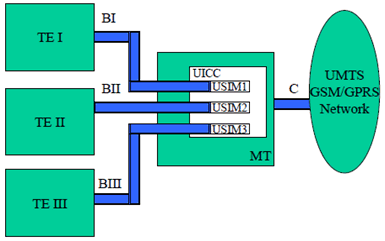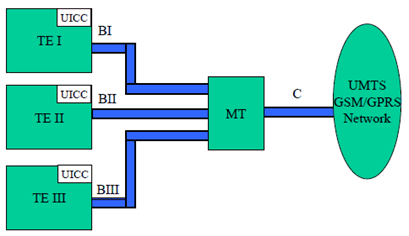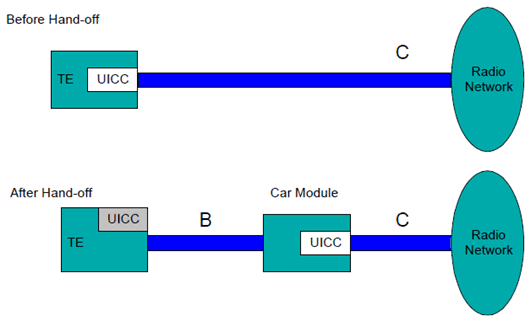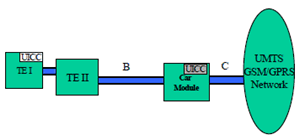Content for TR 22.944 Word version: 18.0.1
A Example Scenarios p. 10
These scenarios were studied and deferred to a later release. They are not enabled by the requirements outlined in this TR.
Scenario 2
In this case, multiple SIM/USIM applications are stored on the MT on a single UICC. Each application (that may be associated with its own unique user) has its own unique SIM/USIM associated with it. The billing is associated with the subscriber's identity stored in the SIM/USIM.

Figure A-1: Multiple users, multiple "borrowed" subscriber identities
(⇒ copy of original 3GPP image)
(⇒ copy of original 3GPP image)
Editors Note: Release 99 allows multiple USIMs stored to be stored on a UICC but they cannot be all active at the same time. In Release 4, the support of logical channels on the UICC enables multiple USIM activation. However, for any registered UICC it is assumed that only one SIM/USIM can be active at any given time.
The scenarios discussed above can be divided into two categories based on the number of simultaneously active subscriptions per user equipment configuration. Scenario 1 and Scenario 2 are examples of cases where there is a single active subscription per UE. This implies that for these scenarios:
In this case, every user uses subscription per device and each device (e.g. PC, PDA) have a UICC. The MT does not use an UICC, even if an UICC is physically present. In this case, each TE is independent and billed for separately. The MT in this case is used as transmitter with multiplexing capabilities and the CK and the IK are handled by the TEs
- The user equipment combination shall contain only one active SIM/USIM.
- The user equipment combination shall contain only one active MT.
- All MTs and TEs in a particular user equipment combination shall be treated by the 3GPP system as being under the responsibility of the subscription identified by the active SIM/USIM. All charges made by 3GPP shall be directed to the subscriber identified by the SIM/USIM.

Due to security concerns this case is not possible, since USIM/SIM applications must be collocated with the Mobility Management on the MT. (It is assumed that the Mobility Management functions are located on the MT).
Scenario 4
In this scenario, every user has a subscription i.e. each user has one UICC that resides in a device (TE + MT) such as the mobile phone (like in case 3). However, the user may be able to transition (henceforth, handoff) into using a different MT (which has a UICC with a SIM/USIM application resident) as shown in the figure below.

Comments:
Hand-off during "IDLE" state may be possible for CS/PS domains using existing services offered by each domain. Significant issues arise if this must be accomplished during "active" state. The assumption is that the handoff is accomplished using existing supplementary services (call forwarding, explicit call transfer etc). This is under the assumption that after the handoff the functional split will be the same as the TE and MT split case discussed earlier.

Figure A-4-2: Hand-off, but retain and lend "own" subscriber identity
(⇒ copy of original 3GPP image)
(⇒ copy of original 3GPP image)
In a variation of the scenario under consideration, it may conceivably be possible to use the UICC on the TE while using a borrowed MT. However, this is not possible since the USIM/SIM application and the MM funtion should be collocated and on the MT.